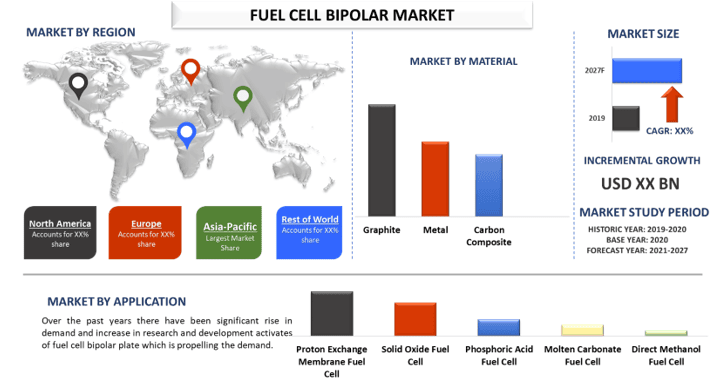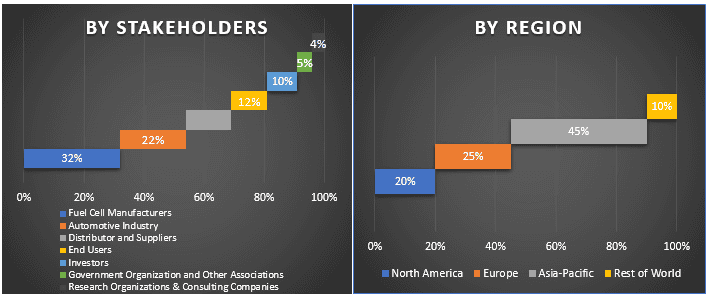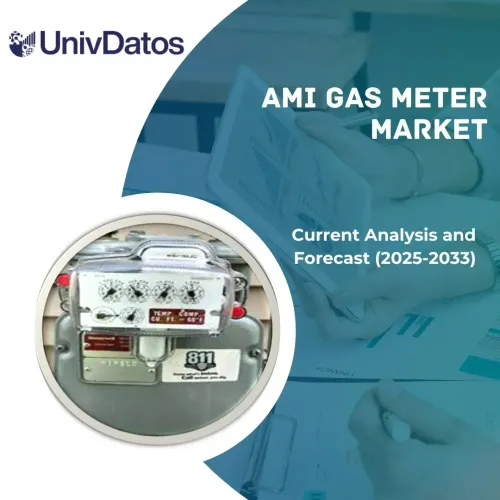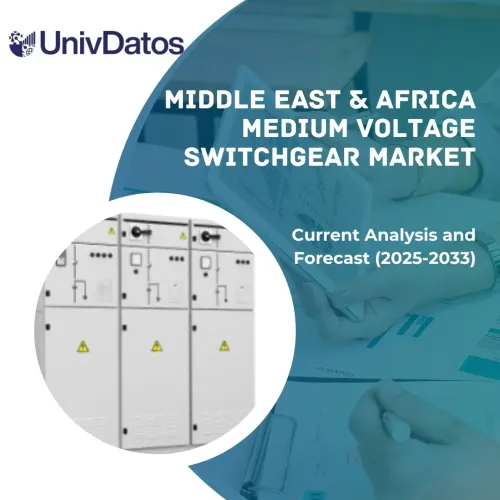- Home
- About Us
- Industry
- Services
- Reading
- Contact Us
Fuel Cell Bipolar Plate Market: Current Analysis and Forecast (2021-2027)
Emphasis on Material (Graphite, Metal, Carbon Composite); Application (Proton Exchange Membrane Fuel Cell, Solid Oxide Fuel Cell, Phosphoric Acid Fuel Cell, Molten Carbonate Fuel Cell, Direct Methanol Fuel Cell), and Region and Country

After COVID 19 outbreak, population is becoming aware of the fact how pandemic naturally reduced carbon emission globally due to shut down of factories, travel and trade thereby switching to renewable and green energy, such as solar and wind and fuel cell operated by hydrogen are considered a promising source of alternative energy production. With capability to handle fluctuations and produce electricity efficiently and quickly fuel cell is gaining significant importance. Apart from consumers, investors are interested in fuel cell bipolar plate which is highly supported by government which can eventually lead to low carbon economy. For instance, China’s government official in a conference, hosted by China Automotive Technology and Research Center (CATARC) in Tianjin told current policies to support new electric vehicles makers offer subsidies on sales, but the new policy will focus on helping companies which have and are developing breakthrough technologies.
During the Covid-19 pandemic in the early 2020, majority of the countries and region witnessed a country wide lockdown. This has impacted the overall demand for fuel cells. Majority of decline was witnessed in the industrial sector, where countries had imposed shut down of manufacturing facilities to reduce the spread of Covid-19 by disrupting the supply chain of fuel cells. However, demand for fuel cell is expected to come to normal post 2020.
Insights Presented in the Report
“Amongst material, graphite fuel cell held prominent market share in 2020.”
Based on material, the global fuel cell bipolar plate market is divided into graphite, metal, carbon composite. Foil-based graphite bipolar plate which is advanced type of graphite holds a considerable market share owing to production of thin walled graphite bipolar plates that delivers low corrosion and high electrical and thermal conductivity. For instance, a leading material electro-thermal treatment/purification market player developed a high electrical and thermal conductivity graphite product to meet large fuel cell requirement. In addition, they have utilized their unique techniques to produce high purity and graphite products to improve bipolar plate operating life. Further, by the end of forecast period metal based fuel cells are likely to showcase influential growth rate in the near-term, metal-based fuel cells would replace backup generators, which are currently driven by internal combustion engines.
“Amongst application, proton exchange membrane held lucrative market share in 2020.”
Based on application, proton exchange membrane fuel cell, solid oxide fuel cell, phosphoric acid fuel cell, molten carbonate fuel cell, direct methanol fuel cell are the different types of fuel cell bipolar plate that allowed the fuel cell industry grow at a substantial rate owing to increasing demand of clean energy and device to produce electricity efficiently. Despite of the fact proton exchange membrane fuel cell’s water waste management is complex, it held significant market share as they can operate at relatively low temperatures and can quickly vary their output to meet shifting power demands. Further, solid oxide fuel cell may showcase robust growth during the forecast period owing high power efficiency and durability, low emissions, flexibility with fuel and relatively low cost. In addition, advancements are being made to reduce the high operating temperature which reduces its mechanical and chemical compatibility and increases start-up times.
“Asia Pacific represents considerable markets in the Global Fuel Cell Bipolar Plate Market.”
For a better understanding of the market adoption, report provide detailed analysis for major region and countries including North America (US, Canada, Rest of North America), Europe (Germany, UK, France, Spain, Rest of Europe), Asia-Pacific (China, Japan, India, Australia, Rest of APAC), and Rest of World. Asia Pacific is expected to see a high demand for fuel cell technology owing to the growing use of fuel cell-powered vehicles in the region. Also, the increasing power generation from cleaner energy sources is further expected to boost the advances in fuel cell technology market in the region. Moreover, presence of major fuel cell manufacturing companies like Asia Pacific Fuel Cell Technologies and Fuji Electric are operating in the region thereby helping automotive industry to grow.
Reasons to buy this report:
- The study includes market sizing and forecasting analysis validated by authenticated key industry experts
- The report presents a quick review of overall industry performance at one glance
- The report covers in-depth analysis of prominent industry peers with a primary focus on key business financials, product portfolio, expansion strategies, and recent developments
- Detailed examination of drivers, restraints, key trends, and opportunities prevailing in the industry
- The study comprehensively covers the market across different segments
- Deep dive country level analysis of the industry
Customization Options:
The global fuel cell bipolar plate market can further be customized as per the requirement or any other market segment. Besides this, UMI understands that you may have your own business needs, hence feel free to connect with us to get a report that completely suits your requirement
Table of Content
Analyzing the historical market, estimation of the current market, and forecasting the future market of the fuel cell bipolar plate were the three major steps undertaken to create and analyze its adoption across the globe. Exhaustive secondary research was conducted to collect the historical market numbers and estimate the current market size. Secondly, to validate these insights, numerous findings and assumptions were taken into consideration. Moreover, exhaustive primary interviews were also conducted, with industry experts across the value chain of the fuel cell industry. Post assumption and validation of market numbers through primary interviews, we employed a bottom-up approach to forecast the complete market size. Thereafter, market breakdown and data triangulation methods were adopted to estimate and analyze the market size of segments and sub-segments the industry pertains to. Detailed methodology is explained below:
Analysis of Historical Market Size
Step 1: In-Depth Study of Secondary Sources:
Detail secondary study was conducted to obtain the historical market size of the fuel cell bipolar plate market through company internal sources such as annual report & financial statements, performance presentations, press releases, etc., and external sources including journals, news & articles, government publications, competitor publications, sector reports, third-party database, and other credible publications.
Step 2: Market Segmentation:
After obtaining the historical market size of the fuel cell bipolar plate market, we conducted a detailed secondary analysis to gather current market insights and share for different segments & sub-segments for major regions. Major segments included in the report are by material and application. Further regional and country-level analyses were conducted to evaluate the overall adoption of the fuel cell bipolar plate globally.
Step 3: Factor Analysis:
After acquiring the historical market size of different segments and sub-segments, we conducted a detailed factor analysis to estimate the current market size of fuel cell bipolar plate. Further, we conducted factor analysis using dependent and independent variables such as growing industrial sector, growing demand for clean energy due to growing urban population etc. A thorough analysis was conducted for demand and supply-side scenario considering top partnerships, merger and acquisition, business expansion, and product launches in the fuel cell bipolar plate industry.
Current Market Size Estimate & Forecast
Current Market Sizing: Based on actionable insights from the above 3 steps, we arrived at the current market size, key players in the global fuel cell bipolar plate market, and market shares of each segment. All the required percentage shares split, and market breakdowns were determined using the above-mentioned secondary approach and were verified through primary interviews.
Estimation & Forecasting: For market estimation and forecast, weights were assigned to different factors including drivers & trends, restraints, and opportunities available for the stakeholders. After analyzing these factors, relevant forecasting techniques i.e., bottom-up approach was applied to arrive at the market forecast to 2027 for different segments and sub-segments across the major regions globally. The research methodology adopted to estimate the market size encompasses:
- The industry’s market size, in terms of value (US$) and the adoption rate of fuel cell bipolar plate across the major markets
- All percentage shares, splits, and breakdowns of market segments and sub-segments
- Key players in the fuel cell bipolar plate in terms of services offered. Also, the growth strategies adopted by these players to compete in the fast-growing market.
Market Size and Share Validation

Primary Research: In-depth interviews were conducted with the Key Opinion Leaders (KOLs) including Top Level Executives (CXO/VPs, Sales Head, Marketing Head, Operational Head, and Regional Head, Country Head, etc.) across major regions. Primary research findings were then summarized, and statistical analysis was performed to prove the stated hypothesis. Inputs from primary research were consolidated with secondary findings, hence turning information into actionable insights.
Split of Primary Participants in Different Regions
Market Engineering
Data triangulation technique was employed to complete the overall market estimation and to arrive at precise statistical numbers of each segment and sub-segment of the global fuel cell bipolar plate market. Data was split into several segments & sub-segments post studying various parameters and trends in the areas of material and application.
The Main Objective of the Fuel Cell Bipolar Plate Market Study
The current & future market trends of global fuel cell bipolar plate were pinpointed in the study. Investors can gain strategic insights to base their discretion for investments from the qualitative and quantitative analysis performed in the study. Current and future market trends would determine the overall attractiveness of the market at a country level, providing a platform for the industrial participant to exploit the untapped market to benefit as a first-mover advantage. Other quantitative goals of the studies include:
- Analyze the current and forecast market size of fuel cell bipolar plate in terms of value (US$). Also, analyze the current and forecast market size of different segments and sub-segments
- Segments in the study include areas of material and application
- Defined analysis of the regulatory framework for the fuel cell bipolar plate industry
- Analyze the value chain involved with the presence of various intermediaries, along with analyzing customer and competitor behaviors of the industry
- Analyze the current and forecast market size of the fuel cell bipolar plate for the major countries
- Major regions/countries analyzed in the report includes North America (US, Canada, Rest of North America), Europe (Germany, UK, France, Spain, Rest of Europe), Asia-Pacific (China, Japan, India, Australia, Rest of Asia-Pacific), and Rest of World.
- Company profiles of the fuel cell bipolar plate players and the growth strategies adopted by them to sustain in the fast-growing market
Deep dive country level analysis of the industry
Related Reports
Customers who bought this item also bought










